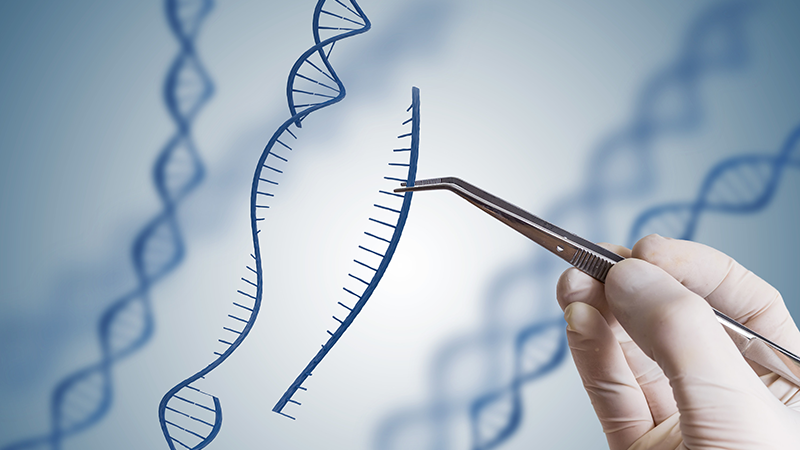N-glycanase 1 deficiency, or “NGLY1,” is a rare genetic disorder arising from mutations in the ngly1 gene. The disease was recently diagnosed in what was a remarkable partnering of patient advocates and scientists who used DNA sequencing to trace the disease-causing mutations to ngly1. Here I’ll describe some of our progress on NGLY1.
Probably all of the proteins encoded by our genome are chemically modified in some way after they are synthesized. One type of modification is N-glycosylation, where a sugar molecule, or “glycan,” is linked to a nitrogen atom on a protein (see figure below). Typically, that nitrogen is in the side chain of the amino acid asparagine. The N-glycosylation modification commonly occurs in cell membrane associated proteins and in proteins that are secreted.
Unusual N-glycan structures can indicate that their associated protein is not folded properly, and flag the misfolded protein so that it will be degraded. A first step for proper degradation of misfolded N-glycosylated proteins is to remove the N-glycans. The product of the ngly1 gene, the Ngly1 protein, catalyzes N-glycan removal. Huang et al. provided evidence that in ngly1 mutant cells, N-glycan removal happens incompletely by another enzyme ENGase, and N-GlcNAc residues remain (see figure above). These N-GlcNAc’d proteins are aggregation prone, and may be toxic.
An isoform of the Human Ngly1 protein we’ve analyzed is 654 amino acids in length. From amino acids 19-109 is the “PUB” domain, which interacts with the protein p97 to form a complex that aids in degradation of misfolded N-glycoslyated proteins in the proteasome (see figure below via Li et al.). The “Transglut_core” of Ngly1 spans from amino acids 275-354, and based on studies in yeast, carries out deglycosylation activity. The third major recognizable domain in Ngly1 is the “PAW” domain, which spans from amino acids 487 to 579. Zhou et al. showed that the PAW domain functions to bind to the glycan chain, probably to anchor Ngly1 to enable protein deglycosylation.
Drosophila and Human Ngly1 proteins are 33.1% and 51.1% identical and similar, respectively. An ngly1 ortholog in Drosophila provides an opportunity to use powerful fly genetics and cell biology to learn more about how Ngly1 functions, and how cells are disrupted when ngly1 is mutated. Interestingly, the amino acids altered in patients with NGLY1 are conserved in Drosophila Ngly1 (table below). Three of the five known ngly1 mutations (R401X, R458fs, R542X) are predicted to lead to a truncated protein either lacking or carrying a disrupted PAW domain.
Using CRISPR, we worked with Tom Lee at Genetivision to create a Drosophila NGLY1 fly that will produce a truncated Ngly1 protein lacking the PAW domain. Our strategy was to insert a stop codon upstream of the PAW domain. We also chose to insert a copy of the white gene downstream of the new stop codon. The white gene gives flies pigmented eyes. So, with our strategy, flies with pigmented eyes should also have the new stop codon in ngly1. Looking for flies with pigmented eyes is a lot easier and cheaper then using molecular biology based methods.
CRISPR genome editing requires designing and building gRNAs. gRNAs anneal to the genomic site of interest and recruit the enzyme Cas9 which makes a break in the DNA. To pick an ideal gRNA, Tom used the gRNA identification software provided by the University of Wisconsin. The software identifies gRNA sequences that are specific to the genomic region and are next to a necessary PAM sequence. Then it provides a ranked list of gRNAs. We chose to use the top ranked gRNA in the region to increase our chances of creating the mutant fly. Below is an image of the gRNA annealing site in Drosophila ngly1 (green) in Benchling. The positions of R389, R445, and R534 are indicated. Note that these are upstream or within the PAW domain (yellow).
Tom built a donor DNA molecule with homology arms upstream and downstream of the Cas9 cut site (see below). In between those homology arms were the stop codon and the white gene we wanted to introduce. The hope was that the gRNA would guide Cas9 to the ngly1 gene, breaks would be made, and the cell’s DNA repair machinery would use the donor DNA with the stop codon and white gene to repair the break. The end result would be placement of the stop codon and white gene into the ngly1 gene.
Tom and his team injected the gRNA and donor DNA into fly embryos that express Cas9. Luckily, two lines were generated that had inserted the stop codon and white gene just next to the codon for D419. The site of insertion was confirmed through DNA sequencing by PLab’s Tamy Portillo Rodriguez of PCR products that she amplified from ngly1PL flies. In the PCR, one primer annealed to the ngly1 gene and the other primer to the newly inserted white gene (see below).
The new allele, ngly1PL, is predicted to create a truncated Ngly1 protein that lacks the PAW domain. When we crossed ngly1PL flies to ngly1ex14 flies made by Tadashi Suzuki’s lab, only ~15% of the ngly1PL/ngly1ex14 flies survived. This is consistent with the Suzuki Lab’s data, which indicated that ngly1 mutant flies exhibit semi lethality. It also proves that ngly1PL is a loss of function allele. We hope this fly line will be useful to the NGLY1 community, and we at PLab have optimized assays to test promising small molecules for their ability to reverse the defects occurring in the NGLY1 fly.
Lastly, Drosophila has been used as a model organism for genetic research for >100 years, yet until about 2 years ago, when CRISPR arrived, it was extremely laborious and time consuming to edit specific regions of the fly genome. With the help of Genetivision and Tom Lee, we created the ngly1 mutant flies in ~4 months, and the amount of cost/time/labor involved was relatively minimal. It’s been incredible to see this powerful method sweep through the life sciences and revolutionize genome engineering at such a rapid pace.








